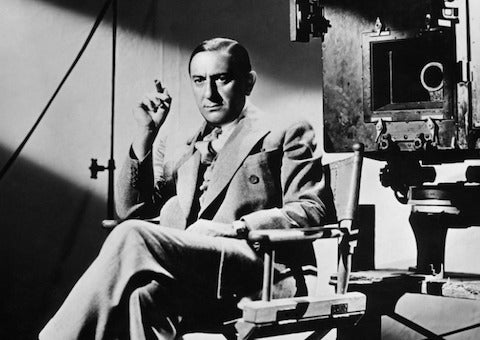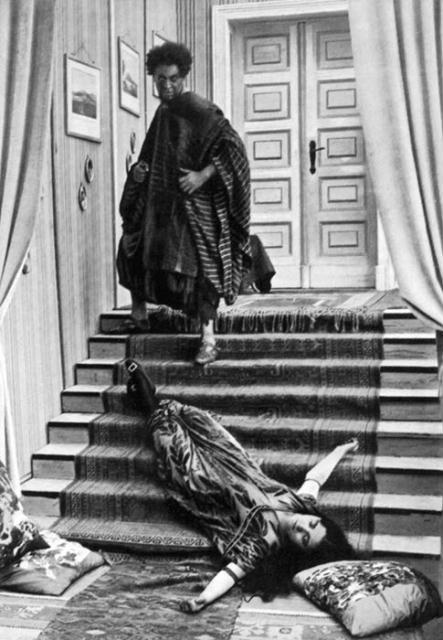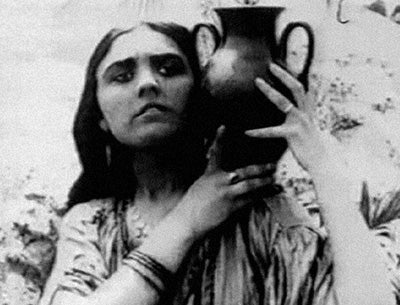
As I mentioned in a blog several weeks ago, I attended a conference in Berlin for the 100th anniversary of Universum Film A.G. (UFA), founded in Berlin in November 1917. In January 1918, Ernst Lubitsch, the most prominent director working under the UFA banner, was just making the transition from comedy to drama.
At the beginning of the year, Lubitsch was working at the Projektions A.G. “Union” (one of the companies subsumed under UFA) with producer Paul Davidson, directing comedies, having previously acted in a series of short comedy films. With increased capital available from UFA, Davidson encouraged Lubitsch to branch out into dramas. At first Lubitsch had his doubts, since he had never directed a costume drama, but Davidson convinced him that it would be an opportunity to direct a “Großfilm” (epic film) with expensive sets and costumes. Davidson also insisted he work with a young Polish actress, Barbara Apolonia Chalupec, who had recently been brought to Berlin from Warsaw by Max Reinhardt’s agent. She had made several films in Poland, and a few shorts in Germany, but was still relatively unknown. Davidson wanted to put her into something tragic, befitting her jet black hair, brooding eyes, and new name: Pola Negri. Lubitsch noted later in a press report, though: “I didn’t want to do it, although I wanted to get Negri into my hands. It was however no small enticement to expose my actor friends Harry Liedtke and Emil Jannings to the problems of drama.”

With production commencing in May 1918 at UFA’s Tempelhof Studios, Die Augen der Mumie Ma [The Eyes of the Mummy] featured Lubitsch’s regular film crew, including Hanns Kräly and Emil Rameau as scriptwriters, cinematography by Theodor Sparkuhl and Alfred Hansen, and sets by Kurt Richter. Once shooting began, rumors began circulating in the industry about the insanity happening in Tempelhof, since Lubitsch had insisted on building realistic sets, rather than utilizing painted backdrops, as was the custom. It was the last summer of World War I, so people were starving in Berlin while material shortages were rampant, making the endeavor all the more controversial. However, in cashing in on the international success of historical epics like Quo Vadis? (dir. Enrico Guazzoni, 1913), the film became a huge hit for everyone concerned when it was released in October 1918. Critics were ecstatic in their praise, not only for Negri, but also Emil Jannings, both actors highlighting their animalistic instincts.
The plot of The Eyes of the Mummy is deceptively simple: young painter Albert Wendland (Harry Liedtke) is taking a tour of Egypt and wishes to visit the tomb of the ancient princess Ma. Despite discouragement from the locals, Wendland finds the tomb, which is guarded by a shady Arab character named Radu (Emil Jannings). Supposedly, the tomb’s mummy opens its eyes to scare away the tourists. Inside the tomb, Wendland discovers a beautiful slave girl (Pola Negri) who has been imprisoned there by Radu, and frees her from the clutches of her evil master. He takes her to Germany where she becomes a famous dancer, but Radu follows the couple and eventually kills both Ma and himself, fulfilling the legend of the revenge of the Pharaohs.

With the first act playing in Egypt, Lubitsch had the opportunity to exhibit various set pieces, including a tomb from antiquity, desert landscapes, and the Cairo market with a variety of exotic vendors. However, it was the erotic dancing of Pola Negri that caused a sensation, her exotic looks and sexualized body consciously put on display to agitate the desires of her “civilized” male audience (and filmgoers). Furthermore, Emil Jannings, playing in blackface, exposes the violence and brutish nature of his character, qualities he would show again and again in later German classics like Variety (dir. E.A. Dupont, 1925). Jannings and Negri would go on to appear together and separately in numerous other Lubitsch films in Germany and America, including Carmen (1918), Madame DuBarry (1919), Sumurun (1920), The Loves of Pharaoh (1921), Forbidden Paradise (1924) and The Patriot (1928), the latter two films made after all three had gone to Hollywood.
Look for our Ernst Lubitsch retrospective this summer at the Billy Wilder Theater.
< Back to Archival Spaces blog






 Mobile Navigation
Mobile Navigation

